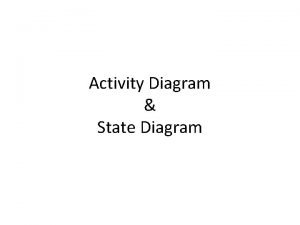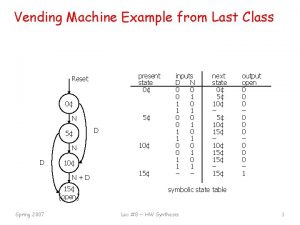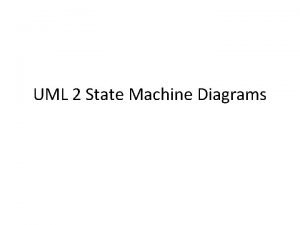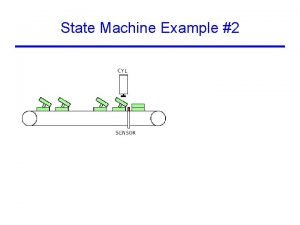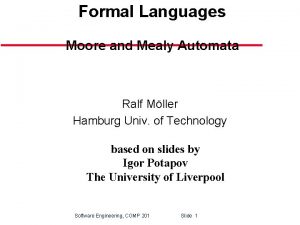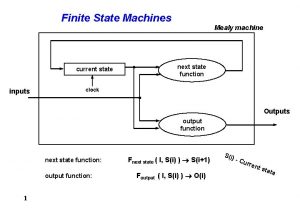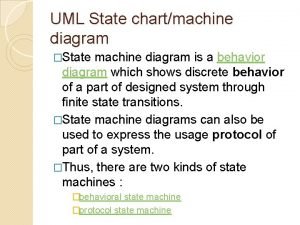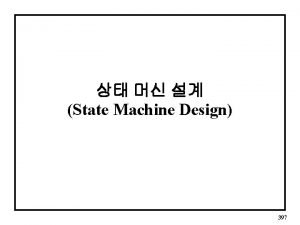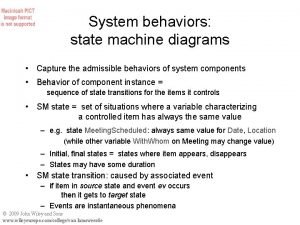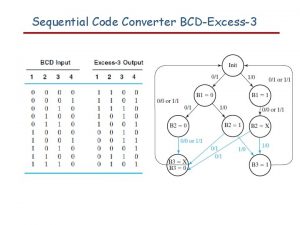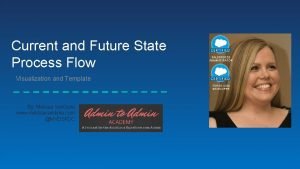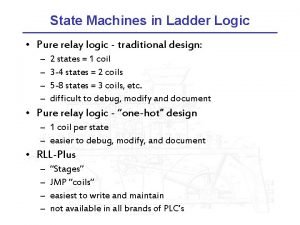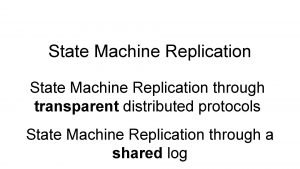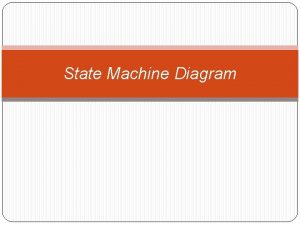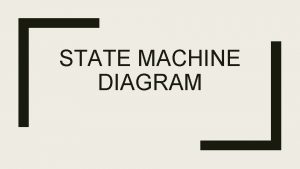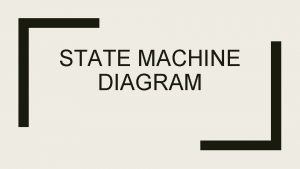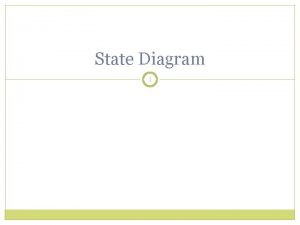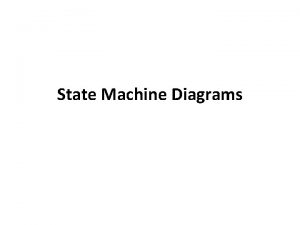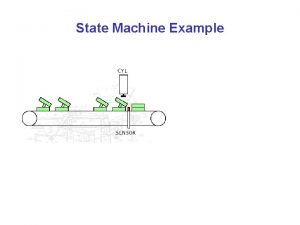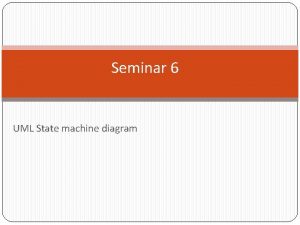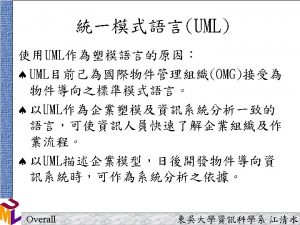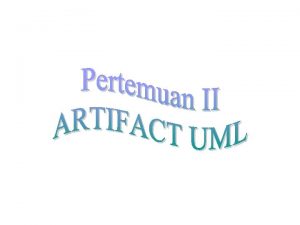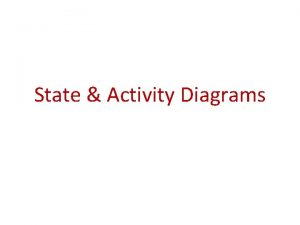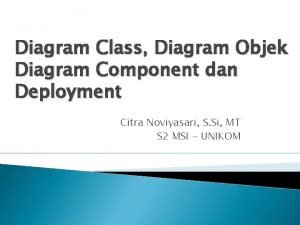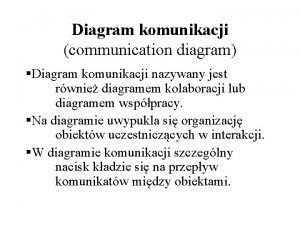State Machine Diagram Chapter 10 State Machine Diagram


![State Machines • Simple set of notational elements trigger[guard]/activity Initial state (pseudo-state) Final state-name State Machines • Simple set of notational elements trigger[guard]/activity Initial state (pseudo-state) Final state-name](https://slidetodoc.com/presentation_image_h2/649036fa6d5188e6d68adce253c2da6c/image-3.jpg)
















- Slides: 19

State Machine Diagram Chapter 10

State Machine Diagram • Used to describe system behavior
![State Machines Simple set of notational elements triggerguardactivity Initial state pseudostate Final statename State Machines • Simple set of notational elements trigger[guard]/activity Initial state (pseudo-state) Final state-name](https://slidetodoc.com/presentation_image_h2/649036fa6d5188e6d68adce253c2da6c/image-3.jpg)
State Machines • Simple set of notational elements trigger[guard]/activity Initial state (pseudo-state) Final state-name State transition Super state

Start/Final states • Start state indicates where the state machine starts • Final state indicates that the machine should terminate

States • Intermediate state of the system state-name entry/activity exit/activity trigger/internal activity … – entry/activity: perform the activity when the state is entered – exit/activity: perform the activity when the state is exited – trigger/internal activity: perform the internal activity whenever trigger occurs

Activity state • Think of this as a state with a separate running thread that can be interrupted at any time – As opposed to being in a “regular” state just waiting for a trigger to arrive state-name do/activity – Note that a trigger[guard]/activity (next slide) cannot be interrupted

Super state • Just a way of grouping states to remove clutter from a diagram – When two or more states have the same transition[guard]/activity (next slide) to the same next state you can group them together and not have to show each and every individual transition x[y]/z

Concurrent states • When you have multiple state machines running concurrently (threads or multi-processing) – The history pseudo state (H) indicates the default state when entire machine is started H

Transition • Cause the current state of the machine to change from state to another trigger[guard]/activity – trigger: event that occurs causing the change – [guard]: condition that must be true for the change to occur – activity: action performed as a result of the transition

Transition • All three parts are optional – If there is no specified trigger, the state performs any enter/exit/internal activities then leaves immediately • Transitions out of a single state must be unique with respect to trigger[guard] specifications – Unless you want a stochastic system (randomly choose the transition when the trigger[guard] occurs) • Can use logical connectors (and, or, not)

Summary • Processing begins at initial state • Proceeds to intermediate states – Event triggered transition • Leave one state, enter the next – Unconditional transition • Processing in the state finishes (e. g. start state) – Concludes when the (a) final state is reached • May be more than 1 final states

Example Login characters typed <cr> typed Enter Password Authenticate User invalid user

State Machines (cont. ) • Like everything else, state machines will be developed through a series of refinements • The process ends when all states are “self-explanatory” • The process results in a hierarchy of state machines • Root node of the hierarchy is the system itself

State Machines (cont. ) • Note that these are NOT flow charts!!! – Flow charts provide a one-to-one correspondence with code – State machines provide a one-to-one correspondence with architectural elements

Specification Changes

Scoring • Manual mode only • Score counter starts at 0 • Increments by 1 each time the ball hits the paddle • Stops incrementing when the ball moves below the paddle (game ends) • Should be displayed at all times

Difficulty levels • Manual mode only • When the number of paddle hits (score) is a multiple of 10 but not a multiple of 20, increase the speed of the ball by 5% • When the number of paddle hits (score) is a multiple of 20, decrease the size of the paddle by 5%

Score database • When a game ends (see scoring on previous slide) have the user enter their name and save the name/score in a “database” • Add a button to show the top 10 scores and the player names • Add a button to show all scores for a particular player (read the player name from the user)

Deliverables • Sequence diagram(s) • User interface design (mock-up) • State machine diagram for the user interface • Revised specification • Due two weeks from tonight – Be prepared to discuss next week
 State activity diagram
State activity diagram Finite state machine vending machine example
Finite state machine vending machine example Vending machine state diagram
Vending machine state diagram State machine diagram
State machine diagram State diagram for washing machine
State diagram for washing machine Mealy automata
Mealy automata Mealy
Mealy Behavioral state machine diagram
Behavioral state machine diagram Mealy machine generator
Mealy machine generator State machine diagram example
State machine diagram example Asynchronous circuit
Asynchronous circuit Current state vs future state diagram
Current state vs future state diagram Moore machine and mealy machine
Moore machine and mealy machine Moore machine to mealy machine
Moore machine to mealy machine Energy work and simple machines chapter 10 answers
Energy work and simple machines chapter 10 answers Tcp header segment
Tcp header segment Quartus technology
Quartus technology State diagram to ladder logic
State diagram to ladder logic Distributed state machine
Distributed state machine Altera quartus web edition
Altera quartus web edition
